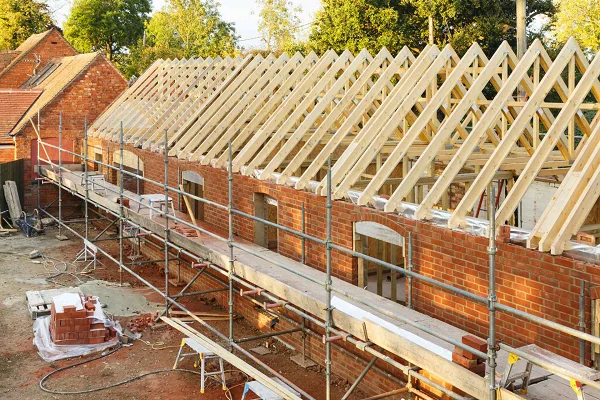What is Meant by Development Finance?
The term “development finance” holds a crucial place in the finance sector. But what exactly is meant by development finance? In this blog post, we’ll unravel the intricacies of development finance, exploring its meaning and purpose and how it plays a pivotal role in bringing ambitious projects to life.
Defining development finance
Development finance is a specialised form of funding designed to facilitate the construction, renovation, or expansion of real estate projects. Unlike traditional mortgages or standard loans, which are typically used for property purchases, development finance is tailored to support the entire life cycle of a development project.
Key features of development finance
Project-Centric Approach
Development finance focuses on the specific needs of a development project, taking into account the costs associated with land acquisition, construction, and other development-related expenses.
It’s a bespoke financial solution that recognises the unique challenges and timelines of property development.
Risk Mitigation
Development projects inherently carry risks, ranging from construction delays to market fluctuations. Development finance is structured to mitigate these risks by providing flexibility and accommodating unforeseen challenges during the project’s lifecycle.
Structured Drawdowns
Unlike a lump-sum payment, development finance often involves structured drawdowns. Funds are released in stages, corresponding to different phases of the project, ensuring that capital is allocated efficiently and tied to project milestones.
Security and Collateral
Lenders offering development finance typically secure the loan against the property being developed. The value of the property and the feasibility of the project are crucial considerations for lenders when assessing the loan.
Tailored Repayment Plans
Repayment plans for development finance are often customised to align with the project’s timeline and cash flow. This could involve interest-only payments during the construction phase, with the principal repaid upon project completion or through the sale or refinancing of the developed property.
Professional Oversight
Lenders offering development finance often work closely with experienced professionals, including surveyors and project managers, to monitor the progress of the development. This ensures that the funds are used efficiently and in line with the project plan.
Development finance serves as a cornerstone for turning ambitious visions into tangible structures. It is a financial instrument that recognises the unique demands of property development, providing a tailored solution to address the challenges and complexities inherent in these projects.
As you delve into the world of property development, understanding the nuances of development finance becomes paramount. Whether you’re a seasoned developer or embarking on your first project, working with reputable lenders and financial experts can help you navigate the landscape of development finance, unlocking the potential to shape the future, brick by brick.
Which banks offer a bridging loan?
Bridging Loans: navigating the maze of lenders in the UK
In the dynamic world of property finance, bridging loans have emerged as a crucial tool for individuals and businesses seeking short-term funding solutions. These specialised loans provide temporary financial support, typically bridging the gap between the sale of one property and the purchase of another or covering unforeseen expenses. While bridging loans offer a valuable lifeline, navigating the maze of lenders in the UK can be a daunting task. This blog post aims to shed light on the landscape of bridging loan providers, highlighting the key considerations and recommending a trusted broker to guide you through the process.
The landscape of bridging loan providers in the UK
Bridging loans are offered by a diverse range of financial institutions in the UK, encompassing traditional banks, specialist bridging lenders, and private equity firms. Each lender has its own set of criteria, interest rates, and terms, making it essential to conduct thorough research and compare options before making a decision.
Traditional banks:
Several high-street banks in the UK, such as Barclays, HSBC, and NatWest, offer bridging loans to their customers. These banks typically have stringent eligibility requirements and may prioritise lending to existing customers with a strong credit history.
Specialist bridging lenders:
A growing number of specialist bridging lenders have emerged in the UK, catering specifically to the needs of borrowers seeking short-term financing. These lenders often offer more flexible criteria and quicker turnaround times compared to traditional banks.
Private equity firms may also provide bridging loans, often for larger property transactions or complex scenarios. However, these loans may come with higher interest rates and more stringent terms.
Key considerations when choosing a bridging loan provider:
- Purpose of the loan: Clearly define the purpose of the bridging loan, whether it’s for property purchase, business funding, or unforeseen expenses. This will help narrow down your options.
- Loan amount: Determine the exact amount of funding required. Lenders may have minimum and maximum loan amounts they are willing to provide.
- Property value: The value of the property being used as security will play a significant role in determining the loan amount and interest rates.
- Repayment period: Bridging loans typically have shorter repayment periods compared to traditional mortgages, ranging from a few months to several years.
- Interest rates: Interest rates on bridging loans can vary depending on the lender, loan amount, and repayment period. Carefully compare rates and factor in any additional fees or charges.
Navigating the maze with a trusted broker
Given the complexity of bridging loan options and the importance of securing the right terms, seeking guidance from an experienced broker can be invaluable. A reputable broker can act as an intermediary between borrowers and lenders, providing expert advice, comparing options, and negotiating favourable terms on your behalf.
UK Property Finance: a trusted broker for bridging loan solutions
At UK Property Finance, we stand out as one of the leading providers of bridging loan solutions in the UK. With a vast network of lenders and a deep understanding of the market, ukpropertyfinance.co.uk can help you find the most suitable bridging loan for your specific needs. Their team of experienced brokers will guide you through the entire process, from the initial assessment to securing the loan, ensuring a smooth and successful outcome.
Bridging loans offer a valuable financial tool for individuals and businesses seeking short-term funding. While the landscape of lenders can be overwhelming, careful research, understanding your requirements, and seeking guidance from a trusted broker like ukpropertyfinance.co.uk can empower you to navigate the maze of bridging loan options and secure the right solution for your needs. Embrace your property dreams with confidence and financial prudence.
Bridging Loan for Fast Home Purchases
Having found your perfect home at a price you can afford, you suddenly find yourself in a major race against time. Given the attractiveness of the property and its price, it’s highly unlikely you are the only interested buyer.
This is where the limitations and imperfections of conventional mortgage loans become painfully apparent. You can comfortably afford the repayments on the mortgage you need, and your deposit is good to go, but you are still at the mercy of your bank’s standard underwriting and processing times.
All of this means you could be waiting as long as 12 weeks to get your hands on the money you need, during which there is a high likelihood of being beaten to the punch.
A Faster and Simpler Alternative
Ferocious competition on the housing market has spurred a major spike in bridging finance enquiries and applications over the past two years. Bridging finance differs from a conventional mortgage in that it is a strictly short-term facility.
With a bridging loan, you are able to raise money against the equity you have in your current home and use it to buy your next home outright. Importantly, a typical bridging loan can take as little as a few working days to arrange, giving you every chance of being at the very front of the queue.
You purchase your next home for cash, and you repay your bridging loan in full when your previous home sells. In the meantime, interest is added at a rate as low as 0.5% per month, making bridging finance usually cost-effective when repaid promptly.
If you are completely confident your home will sell in the near future without any issues, a bridging loan could prove so much more affordable than a conventional mortgage.
What is the Difference Between an Open and Closed Bridging Loan?
If you decide to apply for a bridging loan to purchase a property fast, you will come across two different loan options, open and closed bridging loans:
Open Bridging Loans. This is a bridging loan that is issued without a fixed repayment date. Your lender will expect to be repaid within a certain period of time, but no specific repayment date is agreed upon during the application process. As a higher-risk loan on the part of the lender, open bridging tends to be slightly more expensive.
Closed Bridging Loans. With a closed bridging loan, you commit yourself to an exact repayment date, by which the full balance of the loan will be repaid. There may also be the option of repaying earlier to save money, with no additional fees or charges incurred.
Which of the two is suitable for you will be determined by how quickly you believe your home will sell after taking out your bridging loan. If demand is high and your home will sell within no more than a few months, a closed bridging loan could be ideal. If you cannot say for sure when your home will sell, an open bridging loan may be more appropriate.
Will I Qualify for a Bridging Loan?
Eligibility for bridging finance is determined on the basis of two main factors which are security and your repayment plan (exit strategy).
Bridging loans are secured against assets of value, which in this case means the equity you have tied up in your current home. Loans are issued with a maximum LTV of 80%, which means that if you have £400,000 of equity in your current home, you could borrow £320,000.
When buying and selling homes the exit strategy for your bridging loan will be the sale of your current home, if your lender is confident that demand is high enough to guarantee the sale of your home in the near future (and for a good price), they will almost certainly approve your application.
Even with poor credit and/or no formal proof of income, it is still possible to qualify for affordable bridging finance.
Three Trends Set to Influence the Housing Market in 2023
Whether average property prices will fall by 10% or see further growth in 2023 remains to be seen. Depending on whom you ask, the next 12 months could see just about any eventuality become a reality for the UK housing market.
But what is safe to say is that when looking at the state of play today, there are several current trends set to influence the housing market in 2023.
Down valuations on the rise
The growing prevalence of ‘down valuation’ has been wreaking havoc on property transactions across the UK for much of this year. This is where surveyors place a value on a property that is less than its asking price, typically resulting in disputes between lenders and sellers while making it more difficult to close sales.
“As markets change, we can probably expect this difference in opinion to widen,” comments John Baguley at Countrywide Surveying Services.
As far back as the summer, many brokers reported encountering valuations that were as much as 20% lower than agreed property purchase prices, bringing major complications and conflicts into the negotiation process.
“There is a gulf between the reality of what buyers are willing to pay and what surveyors are willing to let go through,” said Jonathan Hopper of Garrington Property Finders.
This is one of many areas in which bridging finance could come into play as a potential solution, enabling buyers to sidestep the usual complications.
“In 2022, the most common use of bridging finance was to overcome a property chain break, surpassing its use to buy investment property,” said Stephen Clark
“We anticipate this will continue into 2023, as down valuations restrict homebuyers’ options, together with falling house prices, rising interest rates, and the cost of living.”
Auctions on the up
The popularity of auction property purchases has been gaining pace throughout the year as mainstream buyers and investors seek affordable homes and commercial properties via non-conventional channels.
Bridging finance provides buyers from all backgrounds with the opportunity to compete directly with cash buyers, enabling the completion of fast transactions while beating rival bidders to the punch.
“We have seen rising demand from auction buyers for bridging finance, enabling them to move at speed with flexible terms,” adds Stephen Clark
“Again, we expect this pattern to repeat itself through 2023 as more properties come up for auction.”
Total bridging loan volumes continue to hover around all-time highs, likely due to the fact that average monthly interest rates remain historically low.
“Some brokers are offering rates below 6% (annually), whereas the Halifax headline rate is above 6%. Bridging loans are extremely competitive at the moment,” commented Vic Jannels on behalf of the ASTL.
A quoted annual rate of 6% on a bridging loan would equate to 0.5% per month, leading up to a uniquely cost-effective facility when repaid promptly.
Putting the brakes on the chain breaks
Avoiding or repairing broken property chains has become the number-one use for bridging finance in the UK for the first time this year. For a broad range of reasons, homebuyers are turning to fast-access bridging loans to enable them to complete planned transactions in time-critical situations.
“Borrowers who have had mortgage products withdrawn with little or no notice or have lost their sale due to their buyers no longer fitting mortgage affordability criteria have turned to short-term funding solutions to ensure their purchase can go through as planned,” says bridging finance expert Stephen Watts.
Following several consecutive years at the top of the table, purchasing investment properties fell to second place in the rankings. Having accounted for 24% of all bridging loans issued in Q2, just 16% of transactions completed in Q3 were for investment property purchases.
Average UK Five-Year Mortgage Rate Falls Below 6%
In what could prove welcome news for at least some prospective borrowers, average interest rates on five-year fixed mortgage deals have fallen below 6%. This is the first time average rates have dipped below 6% since Kwasi Kwarteng’s catastrophic mini budget two months ago, which, along with crippling the UK economy, also cost him his job.
Importantly, experts believe that further reductions are on the horizon and that prospective borrowers could potentially benefit by holding out a little longer.
Newly published data from Moneyfacts shows that five-year fixed-rate mortgage deals are now being offered with an average APR of less than 6% for the first time in seven weeks. Jeremy Hunt’s attempts to calm financial markets and restore some confidence in the UK economy seem to be having an impact, but there is still some way to go before Mr Kwarteng’s damage is fully reversed.
As for whether now is the time to take advantage of this small but welcome reduction in average mortgage rates, the general advice among experts is to hold out a little longer.
“Borrowers may well breathe a sigh of relief to see that fixed mortgage rates are starting to fall, but there may be much more room for improvement,” said Rachel, a finance expert at Money Facts.
“Borrowers who paused their homeownership plans, or indeed parked the idea of refinancing, may now be tempted to scrutinise the latest deals on offer.”
All indications point to further (albeit minor) interest rate falls on the horizon, which, over the course of a typical mortgage, could amount to significant savings for borrowers.
“It is worth noting that rates could fall further still, but there is no clear answer as to how quickly that may be,” Rachel added.
“Indeed, it’s been about two months since both the average two- and five-year fixed mortgage rate breached 5%, but today only a handful of lenders are offering sub-5% fixed deals.”
“Borrowers may feel they have to be patient for a little while longer before they commit to a new fixed mortgage, or even wait until next year to see how the market recovers from the recent interest rate uncertainty.”
A steady drop in house price growth
The news from Moneyfacts comes shortly after the single sharpest drop in average property prices recorded since early last year: down 0.4% in October compared to the month before.
“There’s no doubt the housing market received a significant shock as a result of the mini-Budget, which saw a sudden acceleration in mortgage rate increases,” commented Kim Kinnaird on behalf of Halifax.
Data suggests that annual house price growth for October came out at 8.3%, which is a significant decline from the prior 9.8%. On average, house prices fell by £1,066 between September and October, coming out at £292,598.
Unsurprisingly, the first-time buyer market has been hit hardest of all, as prospective buyers find it increasingly difficult to qualify for high-street mortgages. Many banks have withdrawn their high LTV products entirely; a typical first-time buyer now faces a minimum deposit requirement of around £45,000.
Affordability in the housing market has been all but wiped out by skyrocketing mortgage rates. According to Moneyfacts, the average two-year fixed-rate deal has leapt from 3.25% in June to around 4.24% in September.
Following Kwasi Kwarteng’s disastrous mini-budget, average two-year fixed-rate mortgages temporarily peaked at 6.65% in mid-October. Nerves were calmed slightly following his swift and unceremonious exit, but mortgage rates are still high and set to climb further. Some mortgage payers are likely to find the coming months particularly difficult as their introductory deals come to an end.
Should Property Developers Hire Agents to Find the Best Deals?
One of the first things you learn when you become a property developer is the importance of being at the front of the queue for prime plots or pieces of land. After all, this represents the very foundation of becoming a successful property developer: beating others to the punch where high-potential build units are concerned.
What’s discovered quickly by newcomers to property developments is that there are countless different options available for tracking down land and properties. You can view listings, head to specialist auctions, speak with commercial state agents, and so on. Play your cards right, and with a little luck (i.e., the right place at the right time) thrown into the mix, you could score yourself something seriously profitable.
But when it comes to the best of the sources available, opinions differ from one developer to the next. Many professionals within the sector (established and aspiring) have chosen to go with the ‘armchair’ approach and to put their faith in web portals.
There is no shortage of online resources for developers in search of profitable investment opportunities, and browsing online opens the door to a full nationwide search at the touch of a button. You can even check out what the UK’s major auction houses are planning to put under the hammer and get a head start on your due diligence.
Best of all, you can add your name to a mailing list, set a bunch of preferences, and be alerted each time something pops up that might be of interest to you, all with no effort required on your part.
All is well and good, but there is a flaw to what seems like a wholly logical approach to seeking development opportunities: the fact that there are probably several thousand more developers just like you who have adopted the exact same approach. The army of armchair-dwelling developers who wait for good investment opportunities to fall (literally) into their laps is growing all the time, creating ferocious competition for those who adopt this approach.
Missing out on the best deals?
Even if you are happy to contend with this kind of competition, there is another huge issue with this particular approach. If there is one important lesson to learn about property developments, it is this:
Some (if not most) of the most lucrative deals available are never listed or marketed online.
The best deals of all have a tendency to be completely ‘off-market’ in nature, meaning you will never even catch sight of them by staying glued to your computer. It is not that these plots and properties are not put up for sale or that numerous potential buyers may find themselves bidding against one another to seal the deal.
Instead, it is simply a case of established commercial estate agents being right at the front of the queue, when and where the most enticing deals pop up. The owner of the property or plot being sold puts together a description of what is on offer; they send this to the commercial agents on their mailing lists, and these agents immediately contact the clients on their own books who are looking for these types of investment opportunities.
In doing so, sellers shift their lots with little to no fuss and get the best possible price for them without ever having listed them on the open market.
Of course, all the above only holds any real value if the agents a property developer hires have the right contacts in the first place. Even so, it illustrates how even the most committed approach to ‘armchair’ research as a property developer could still leave you right at the back of the queue.
Myths About Equity Release Uncovered
Falsehoods regarding equity release are rife, with many people believing untruths that are preventing them from taking advantage of the benefits of this type of finance.
In a world where people are retiring earlier and living longer, many homeowners are looking to release built-up equity in their homes. Homeowners are increasingly wanting to stay in the houses they have spent many years upgrading and making their own, resulting in an increase in the popularity of equity release finance products.
Despite the obvious advantages of equity release, there are still various myths that are preventing many people from considering this option.
I could be forced to move
This is not true! You will never be required to move from your home. Lifetime mortgages allow you to remain in the home, and you will remain the official owner with the property staying in your name.
If the property is in joint names, you will have the right to remain resident in the home until the last remaining survivor either goes into permanent care or is deceased. This is regulated by the Equity Release Council.
Interest rates roll up over time, and it’s very costly
This is not necessarily the situation. Lenders will give options regarding the repayment of interest rates. Typically, the interest will be added to the loan total and paid off in full when the home is ultimately sold to repay the loan. You can also decide if you take the equity released as a lump sum or if you prefer it to be paid out in regular payments, a bit like an income.
Many equity release providers will offer the option of paying part or all of the interest during the lifetime of the loan. This means that the interest will not ‘roll up’.
I may end up in negative equity
These days, regulations regarding the financial market are a lot more stringent than they were in the past. The FCA (Financial Conduct Authority) has introduced many regulations to protect consumers. The majority of lenders offering equity releases are also members of the Equity Release Council.
Members of the Equity Release Council are required to provide their clients with a no-negative equity guarantee, which protects the borrower from this worry. This is why it is imperative that you check that the lender you use is a member for your reassurance.
What this means for the borrower is that no matter what happens in the property market, you will never be required to pay more than the value of your home, even if it is less than the amount owing on the loan.
Will I have to take the money in one lump sum?
No, you will not have to take the funds in one go, unless, of course, you choose to do so. This type of loan is flexible, and typically, a lifetime mortgage will release the equity in one lump sum. You will need to continue to make payments on your mortgage as usual.
However, not everyone wants their funds in a lump sum and may choose a ‘drawdown’ option, which releases money in stages. By taking the funds in frequent, smaller amounts, the interest amount added to the loan each month will decrease.
My children will get no inheritance
Many parents in their twilight years will release equity in order to gift to their children as a type of ‘living’ inheritance so that they get the pleasure of seeing their loved ones use the money to improve their lives. There may be an inheritance tax that will be due at some point in the future, but arguably it is far more beneficial for them to get the money when they probably need it the most as opposed to waiting until they themselves are older and probably more established.
Equity release will not be the best choice for everyone, and it is vitally important that you educate yourself on all the pros and cons. For this reason, it is advisable that you consult with a broker who has experience in this sector before committing to any equity release product.
Have Property Development and Construction Costs Peaked?
Property developers and construction companies have not had an easy ride as of late. Ever since the COVID-19 crisis hit, the costs of essential building materials have skyrocketed to unprecedented highs. The war in Ukraine took a further toll on already stretched supply lines, making it impossible for developers to turn a profit without imposing their own lofty price hikes.
With the UK facing its worst collective living-cost crisis in recent history, the immediate outlook for the average household is fairly bleak. But there may be at least a small degree of respite on the horizon for builders and property developers, as construction costs are beginning to plateau.
Better yet, there is reason to believe that building costs will begin to decrease going into 2023, enabling developers and construction companies across the UK to kickstart (or restart) their planned projects.
Will the economic downturn trigger a reduction in building costs?
One of the reasons why building costs increased significantly towards the tail-end of the COVID-19 crisis was the simply insurmountable divide between demand for building materials and available supply. Developers and construction companies across the UK raced to keep up with demand, and in doing so completely swallowed up the available contingency of key materials.
Supply lines dried up, availability of essential materials hit rock bottom and prices skyrocketed as a result.
When this happens, many developers and construction companies decide to shelve planned projects or put their existing projects on hold. They simply had no realistic way of generating meaningful profits with such elevated building costs, so they made the decision to wait things out. Their aim was to sit tight until the market returned to some kind of normality, rather than paying over the odds, and reducing the profitability of their projects in the meantime.
All of this seems to be paying off for many, who have already noted a significant reduction in the cost of some essential building materials. Some have even reported that compared to the end of Q2, they are now receiving quotations up to 10% lower on key materials and components.
These reductions in building costs are resulting from two things: A period of comparatively low demand when costs were disproportionately high and the rectification of a broad range of supply chain issues. Key building materials are still not available in the same plentiful supply they once were but are no longer as difficult to come by.
As a result, the manufacturers and suppliers are not able to charge such high prices for them and low prices are gradually trickling through to property developers and construction companies.
In forwards into 2023
Of course, putting too much stock into what is happening (or appears to be happening) right now may not be advisable. The events of the past few years have taught us that nothing is set in stone, and we have no idea what may be around the next corner.
As the crisis continues to escalate in Ukraine, it is perfectly plausible that major supply chain issues could once again cripple the UK’s property development sector.
Even so, the consensus seems to paint a picture of a slightly more stable and predictable future for the industry as a whole. Building material, component and labour costs may remain elevated indefinitely but are unlikely to hit the same kinds of peaks as those experienced at the height of the COVID-19 crisis.
Property developers and construction companies are exercising greater care and caution than ever before, and in today’s turbulent climate are unwilling to take the kinds of risks they would once have happily accepted as the norm.








